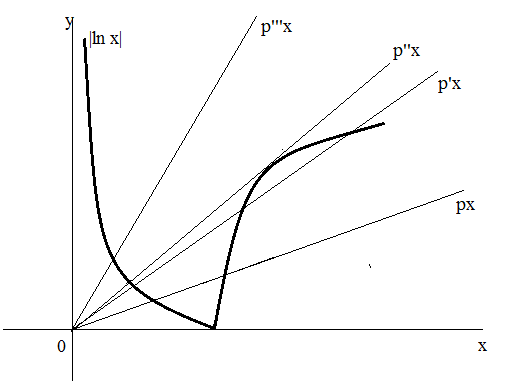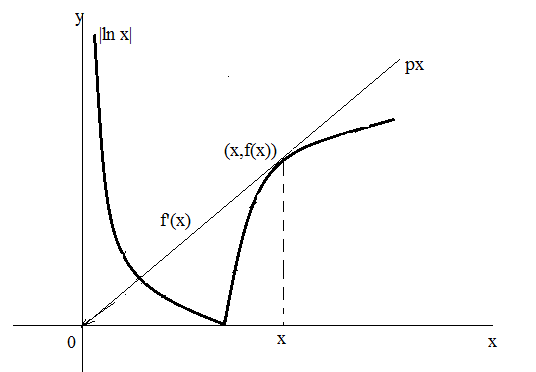
The set of values of p for which the equation $ \left| {\ln x} \right| - px = 0 $ possess three roots is:
A.(0,1/e)
B.(0,1)
C.(0, $ \sqrt 3 $ )
D.(0,e)
Answer
567k+ views
Hint: In this question, we need to determine the set of values of p such that $ \left| {\ln x} \right| - px = 0 $ possess three roots. For this, we will sketch the curve for all the functions present in the equation and evaluate the point of the intersection of the same.
Complete step-by-step answer:
For three roots, the common points in the functions of the equation $ \left| {\ln x} \right| - px = 0 $ must be three. In other words, the curve ‘px’ must cut the curve |ln x| at three points.
Plotting the sketch of the functions present in the given equation $ \left| {\ln x} \right| - px = 0 $ .

From the plot, we can see that the line segment ‘px’ varies with the values of p. The line segment ’p’’x’ is acting as a tangent to the curve. Below the line segment ’p’’x’, we can see that the curve has been cut at three different points.
So, we can say that the value of ‘p’ should be such that the slope of the curve ‘px’ must be less than its tangent.
Hence, the final plot is drawn as

Now, let ‘x’ be the coordinate of the x-axes where the function ‘px’ meets with the function ‘|ln x|’. Then, the value of y-coordinate will be ‘f(x)’.
The slope of the curve is the differentiation of the function with respect to the associated parameter. Mathematically, the slope of the curve is the ratio of the difference of any two points on the y-axis to the difference of any two points on the x-axis.
So,
$
f'(x) = \dfrac{{f(x) - 0}}{{x - 0}} \\
= \dfrac{{f(x)}}{x} \\
$
Here, the function $ f(x) = |\ln x| $ so, the value of $ f'(x) = \dfrac{1}{x} $
Substituting the value of f’(x) in the above equation, we get
$
f'(x) = \dfrac{{f(x)}}{x} \\
\Rightarrow \dfrac{1}{x} = \dfrac{{|\ln x|}}{x} \\
\Rightarrow |\ln x| = 1 \\
\Rightarrow x = e \\
$
Hence, the value of the x- coordinate where the functions meet is x=e.
Therefore, the slope of the line is given by $ \dfrac{1}{x} = \dfrac{1}{e} $ .
Hence, we can say that the value of p must be less than $ \dfrac{1}{e} $ in the first quadrant of the coordinate axes.
So, the set of values of p for which the equation $ \left| {\ln x} \right| - px = 0 $ possess three roots is \[(0,{\text{1/e}})\].
So, the correct answer is “Option ”A.
Note: Roots are the points on the functions of the equation, which are common to all the functions present in the equation. In linear equations, the roots are the points where the function’s value equals to zero.
Complete step-by-step answer:
For three roots, the common points in the functions of the equation $ \left| {\ln x} \right| - px = 0 $ must be three. In other words, the curve ‘px’ must cut the curve |ln x| at three points.
Plotting the sketch of the functions present in the given equation $ \left| {\ln x} \right| - px = 0 $ .

From the plot, we can see that the line segment ‘px’ varies with the values of p. The line segment ’p’’x’ is acting as a tangent to the curve. Below the line segment ’p’’x’, we can see that the curve has been cut at three different points.
So, we can say that the value of ‘p’ should be such that the slope of the curve ‘px’ must be less than its tangent.
Hence, the final plot is drawn as

Now, let ‘x’ be the coordinate of the x-axes where the function ‘px’ meets with the function ‘|ln x|’. Then, the value of y-coordinate will be ‘f(x)’.
The slope of the curve is the differentiation of the function with respect to the associated parameter. Mathematically, the slope of the curve is the ratio of the difference of any two points on the y-axis to the difference of any two points on the x-axis.
So,
$
f'(x) = \dfrac{{f(x) - 0}}{{x - 0}} \\
= \dfrac{{f(x)}}{x} \\
$
Here, the function $ f(x) = |\ln x| $ so, the value of $ f'(x) = \dfrac{1}{x} $
Substituting the value of f’(x) in the above equation, we get
$
f'(x) = \dfrac{{f(x)}}{x} \\
\Rightarrow \dfrac{1}{x} = \dfrac{{|\ln x|}}{x} \\
\Rightarrow |\ln x| = 1 \\
\Rightarrow x = e \\
$
Hence, the value of the x- coordinate where the functions meet is x=e.
Therefore, the slope of the line is given by $ \dfrac{1}{x} = \dfrac{1}{e} $ .
Hence, we can say that the value of p must be less than $ \dfrac{1}{e} $ in the first quadrant of the coordinate axes.
So, the set of values of p for which the equation $ \left| {\ln x} \right| - px = 0 $ possess three roots is \[(0,{\text{1/e}})\].
So, the correct answer is “Option ”A.
Note: Roots are the points on the functions of the equation, which are common to all the functions present in the equation. In linear equations, the roots are the points where the function’s value equals to zero.
Recently Updated Pages
Why are manures considered better than fertilizers class 11 biology CBSE

Find the coordinates of the midpoint of the line segment class 11 maths CBSE

Distinguish between static friction limiting friction class 11 physics CBSE

The Chairman of the constituent Assembly was A Jawaharlal class 11 social science CBSE

The first National Commission on Labour NCL submitted class 11 social science CBSE

Number of all subshell of n + l 7 is A 4 B 5 C 6 D class 11 chemistry CBSE

Trending doubts
What is meant by exothermic and endothermic reactions class 11 chemistry CBSE

10 examples of friction in our daily life

One Metric ton is equal to kg A 10000 B 1000 C 100 class 11 physics CBSE

1 Quintal is equal to a 110 kg b 10 kg c 100kg d 1000 class 11 physics CBSE

Difference Between Prokaryotic Cells and Eukaryotic Cells

What are Quantum numbers Explain the quantum number class 11 chemistry CBSE




